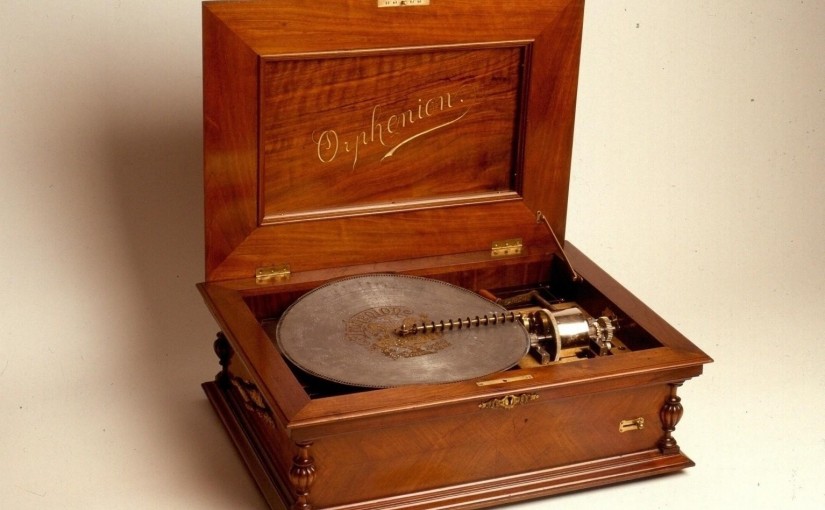By Stephen T. P. Kember
Almost without exception, everybody who visits my shop in Rye, smiles when they hear a musical box play. Why do people find them so interesting? Maybe the mood or feeling of an earlier era is recreated. The sound produced by a properly restored musical box is exactly as it would have been when the machine was new, all those years ago. Each one of us has the opportunity to experience the delight and enchantment felt by say, William Gladstone or Queen Victoria. We can enjoy the entertainment that was so new in that era.
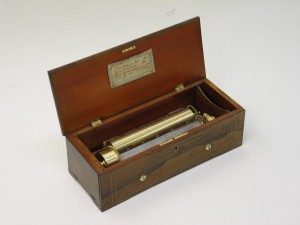
circa 1885 playing 8 airs as listed on original tune sheet. Serial
number 23453 Gamme number 1598 Case 55cm/21.5 inches long, 23cm/9
inched deep, 15cm/6inches high. Burr Walnut with boxwood stringing
and tulipwood crossbanding.
There are two broad categories of musical box, cylinder or disc. Many variations of each type exist. The musical information, or code, necessary for the production of the music is provided by either a pinned cylinder, the pins on the rotating cylinder pluck the teeth on a tuned steel comb. Alternatively, an interchangeable flat disc, whose projections rotate star shaped wheels and pluck the teeth of a tuned steel comb. The cylinder of a musical box will slide on its longitudinal axis to enable more than one tune to be played, each tune occupies one track or position on the cylinder. To change the tune on a disc machine, one merely replaces the disc.
Earlier types of cylinder boxes were often plain, and understated. Despite (or because of) the ‘cottage industry’ manufacturing, these machines often play with a soft tone that can be much sought after in musical box collecting circles. Towards the latter part of the 19th century, production methods became more sophisticated and mechanised. The manufacturers were exporting a large proportion of their output. Attendance at international trade exhibitions gave an idea of what the overseas buyer wanted. Competition drove the manufacturers to supply boxes with ever more elaborate cases and familiar tunes. Brazilian Rosewood veneered cases were popular in the UK and Europe, whilst oak found favour in the US. Cylinder boxes are normally associated with Switzerland. In fact the production and export of musical boxes provided a significant contribution to the 19th century Swiss economy. Cylinder boxes were, however, produced in other countries including France and Austria.
Cylinder boxes have certain obvious limitations. The fixed program of say six, eight or twelve tunes would, perhaps, leave the owner wanting more variety after a while. Interchangeable cylinder musical boxes were expensive and quite cumbersome to use. A German company, Symphonion, solved this problem and produced the first commercially available disc musical boxes in the late 1880’s. The choice of music was potentially unlimited. This extremely robust design was louder and cheaper to produce than the delicate cylinder equivalent.
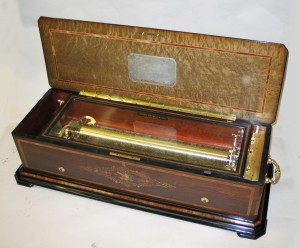
regarded manufacturer, Nicole Freres. Serial number 46334, gamme number
3091, insert date. The 12 airs are played via a massive 58,5 cm cylinder
on two combs (56 and 57 teeth). 12 airs by composers; Rossini, Mendelssohn,
Mayerbeer, Batiste, Handel, Mozart and Auber.
Machines were produced that were coin operated so that they could earn their keep. The manufacturers could keep producing discs as new songs became popular. Symphonion soon faced competition from another disc manufacturer, Polyphon. Polyphon, based in Leipzig, Germany, became so successful that the name has passed into the English language to be used as the generic term for a disc musical box (just like Hoover/vacuum cleaner and Thermos/vacuum flask). As these items were highly sought after, many other manufacturers entered the ring. These included Adler, Britannia, Euphonoion, Fortuna, Kalliope, Komet, Mira, Orphenion and Stella.
The musical box industry began to decline as new forms of home entertainment became available. The phonograph and the wireless turned musical boxes into the redundant technology that people stored in the outhouse or attic. Items once cherished, were left to the ravages of damp and time. Manufacturers then used the engineering skills and experience gained whilst making musical boxes to produce other things (phonographs, cameras, typewriters etc.). The musical box industry all but died. Happily, the once discarded technology has now embarked on a new era of popularity. The restoration techniques that have been developed over the past 40 years or so have enabled once treasured items of domestic entertainment to be resurrected, enabling us to gain an intriguing insight into the world of 19th century entertainment.
Types of disc musical box
Bells
Bells were sometimes added to what would appear to be a standard disc musical box. The bells could take the form of saucer or cup shaped bells, tubular bells or glockenspiel (flat bar) bells.

‘3 Bells in Sight’ cylinder musical box playing 8 airs as indicated
on original tune sheet circa 1890. Tunes include ‘Little Annie Rooney’,
‘Mikado Waltz’, ‘Ask a Policeman’ and ‘Where did you get that hat’.
Case dimensions 43cm (17 inches) x 27cm (10.5 inches) x 22cm (8.5
inches). The cylinder is 15cm (6 inches) long.
Auto change
As the first ‘juke box’, this type of mechanism was most likely to be found on machines to be used in a public space (bar etc.). Obviously complicated and expensive, this variation is mostly found on ‘Polyphons’. The tunes could be selected from a rack of vertically stored discs.
Multiple Disc
Disc machines playing more than one disc at a time allowed the musical arrangers a whole new set of weapons to add to their armoury. Symphonion were one such company producing machines capable of playing two or three discs simultaneously. The ‘Eroica’ is one such example. A set of three discs, marked A, B and C, were needed.
Clocks
Many disc musical boxes had small clocks incorporated into the pediment but Symphonion and Polyphon both collaborated with Lenzkirch to produce large hall clocks of very distinctive form. Symphonion also produced small mantle clocks using 4 ½ inch (11.5 cm) discs.
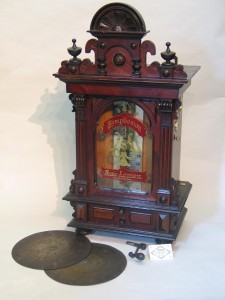
where large numbers of people would gath
Disc Phonographs
By the early 1900’s, the disc musical box era was clearly coming to an end. Some manufacturers produced disc musical boxes capable of playing gramophone discs (powered by the same motor). Although comparatively rare, many of the major disc musical box producers made examples of these combination machines names, ‘Polygraphon’, ‘Reginaphone’ and ‘Miraphone’.
Types of Cylinder Musical box Bells in Sight (or Vue)
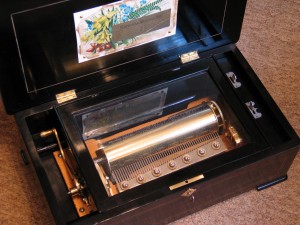
A Swiss cylinder musical box by Ami Rivenc of Geneva, number
39208 circa 1890, playing 10 airs as indicated on original tune sheet.
Cylinder length 24cm (9.5 inches), case 50cm (19.75 inches) x 29cm
(11.5 inches) x 17cm high (16.75 inches).
The first cylinder musical boxes to be offered with bells had them concealed underneath the mechanism, in the bottom of the case. The bells are struck by a hammer attached directly to the underside of the comb tooth. Some manufacturers offered the option of a drum (an up-turned tin!) struck in the same way. It was soon realised that a feature could be made of these options if the bells were placed where they could be seen. The upturned tin was replaced with a properly skinned drum, Castanets (wooden block) followed. The use of highly polished, sometimes nickel-plated, bells and the other accessories were used as a marketing feature. Bell hammers cast in the form of butterflies or bees added further to the appeal. Some bell striking mechanisms were designed in the form of automaton monkeys, Arabs or Japanese figures whose arms moved to strike the bells (some heads moved towards the bell about to be struck).
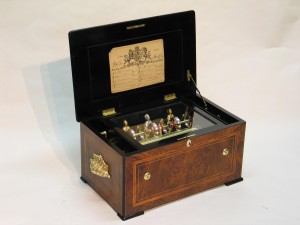
six bells are struck by three automaton figures representing Japanese
gentlemen. An example of how the musical box industry was trying to
adapt to current fashions and changing tastes.
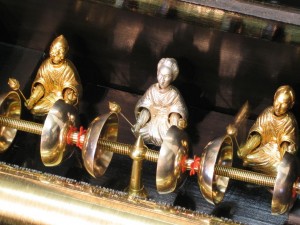
six bells are struck by three automaton figures representing Japanese
gentlemen. An example of how the musical box industry was trying to
adapt to current fashions and changing tastes.
Mandoline (Organocleide)
The distinctive sound produced by a ‘Mandoline’ musical box is produced by a comb that has groups of teeth (5 to 8) tuned to the same pitch. A mandoline box is easily identifiable, as apart from the fact that this feature was distinctly marked on the tune sheet, the pinning produces distinctive patterns at the treble end of the cylinder. The similarly tuned teeth are plucked in quick succession to give the mandoline effect. Laws of nature will not allow a single tooth to be used in this way (musical box teeth need to be damped i.e. vibration reduced, before being plucked to ensure a clean sound). This facility gave the musical arrangers the option of enhancing the music in a distinctive way. The ‘Organocleide’ musical box was a development of the above in that the mandoline pinning is extended to the bass end of the cylinder. Organocleide musical boxes are very rare.

A ’12 airs, Grand Format’ cylinder musical box made by the highly
regarded manufacturer, Nicole Freres. Serial number 46334, gamme number
3091, insert date. The 12 airs are played via a massive 58,5 cm cylinder
on two combs (56 and 57 teeth). 12 airs by composers; Rossini, Mendelssohn,
Mayerbeer, Batiste, Handel, Mozart and Auber.
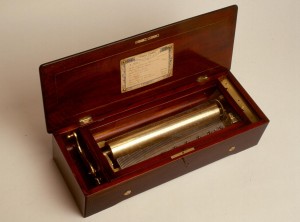
A ’12 airs, Grand Format’ cylinder musical box made by the highly
regarded manufacturer, Nicole Freres. Serial number 46334, gamme number
3091, insert date. The 12 airs are played via a massive 58,5 cm cylinder
on two combs (56 and 57 teeth). 12 airs by composers; Rossini, Mendelssohn,
Mayerbeer, Batiste, Handel, Mozart and Auber.
Interchangeable Cylinders
This development came about around 1850. The first machines of this type were supplied with a series of spare cylinders that could only be used with that particular machine. The manufacturing processes were refined to such an extent that, with later machines, extra cylinders could be bought when required and would fit different musical boxes if built to the same specification (type specific). The cases of these machines also became more elaborate and were incorporated into tables often of large proportion.
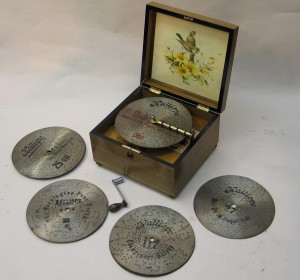
Pianoforte
The music of a pianoforte box is produced from two combs, one loud and one soft. This gave the musical arranger the option of having soft passages of music from the short comb, louder sections from the long ‘forte’ comb and the loudest of all, when the two combs are played together. These are much sought after and rare.
Overture
‘Nicole Freres’ is the manufacturer usually associated this musical box feature. These machines are normally recognisable from the large diameter cylinder and would play three or four operatic overtures. The mechanisms were often supplied in highly decorated cases. The machines are not to be confused with the less sought after ‘two per turn’ musical box. These machines, at first glance, look similar, but play twelve tunes, two tunes for each revolution of the cylinder.
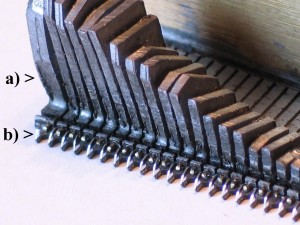
and inverted. a) points to the lead tuning weights that are attached
to the longest teeth. These are the low notes. The manufacturer of
the musical box attached these pieces of lead to the teeth to increase
the mass of the tooth and therefore lower the tooths natural frequency
(lower the note). The tooth could be tuned (remove lead and raise
the note) during the final stages of manufacture. This is when the
engineering stops and the artistry begins. b) points to the delicate
dampers (the curved pieces of wire) that must be correctly adjusted
to ensure a clear sound.
Musical Box Music
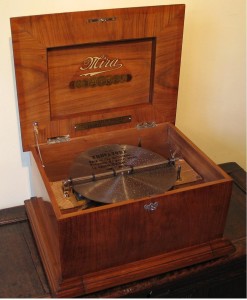
Swiss circa 1905. 32 original discs 30.5 cm (12 inches) in diameter.
The drawer at the bottom of the case is designed to hold a selection
of discs. This musical box plays with a very bright, distinctive tone,
speed regulator and zither.
Musical box manufacturers clearly had to sell the musical boxes that they produced. Consequently the choice of music had to be what was popular with the customers. Current opera and dance tunes would have obvious popular appeal. A market also existed for hymns, national anthems and local folk music.
The more sophisticated, business-minded musical box manufacturers like Nicole Freres, were more ready to adapt themselves to the market that they were operating in. Nicole Freres advertised extensively in the U.K. in the nineteenth century. Many of the tunes found on Nicole Freres boxes had special appeal to the British, this was no accident. Other boxes found, play a selection of tunes clearly destined for the Scottish market.
Much of the upmarket end of the business, in the mid 19th century was represented by well engineered musical boxes playing overtures (from Operas).
By the time the 20th century had arrived, musical boxes were produced in large quantities, often playing popular music hall tunes, Spanish folk music (for the Spanish/South American market) Indian or Chinese music.
What to look for when buying a musical box
Condition is a major consideration when choosing a musical box and assessing its value. Torn or missing tune sheets, lifting veneers or cases damaged by woodworm are some of the more obvious defects that hardly need further comment. The musical mechanism, however, needs careful scrutiny.
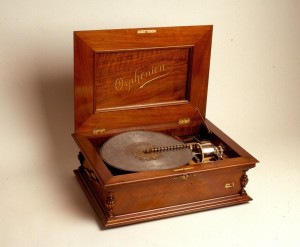
Cylinder
Careful inspection will reveal any bent pins. The bass end or any sections that drive accessories (bells or drums etc.) are especially vulnerable. An excessive number of damaged pins will impair the music and repinning the whole cylinder is the solution!
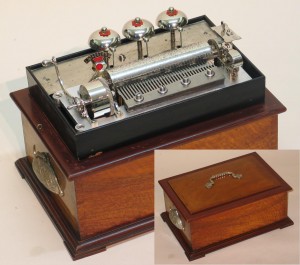
‘3 Bells in Sight’ cylinder musical box playing 8 airs as indicated
on original tune sheet circa 1890. Tunes include ‘Little Annie Rooney’,
‘Mikado Waltz’, ‘Ask a Policeman’ and ‘Where did you get that hat’.
Case dimensions 43cm (17 inches) x 27cm (10.5 inches) x 22cm (8.5
inches). The cylinder is 15cm (6 inches) long.
The Comb
Look for excessive pitting to the surface of the comb, missing teeth and tips and badly repaired sections. Look underneath the Zither (the gantry suspended above the comb that supports a roll of tissue paper) if fitted, it may conceal damage. Corroded tuning weights (suspended beneath the comb) will be indicated by a fine white deposit around the affected area.
The Dampers
Should a whisper, click or grating noise be heard whilst playing, a worn comb or dampers that are out of alignment or missing will be the likely cause. Dampers are small pieces of fine wire fixed to the underside of a comb that curl up to meet the comb tip. In the case of a disc box, the damper, in the form of a delicate leaf spring, will emerge from between the tips of the comb. This spring is often in two parts. The second part forms a brake that will ensure that the star wheel will stop in the correct position next time it is required.
In conclusion
Listen to and observe as many musical boxes as possible before making a commitment. When comparing prices, remember to make a realistic allowance for restoration to ensure that you compare like with like. A machine that has been dormant and not used for many years will not perform as the original manufacturer intended. All machines needs a degree of maintenance. Patina is a wonderful thing on a musical box case or a special piece of furniture but not in the form of congealed oil and grease on an antique piece of machinery.
Protect yourself with experience.
Copyright Stephen T. P. Kember 2011
www.antique-musicboxes.com
www.antiquemusicalboxrepair.info
June 2013 issue of “Rye’s Own”
All articles, photographs and drawings on this web site are World Copyright Protected. No reproduction for publication without prior arrangement.
